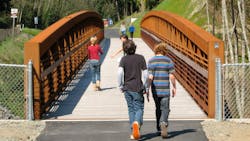WSDOT releases its statewide Active Transportation Plan
The Washington State Department of Transportation (WSDOT) has released its new Washington State Active Transportation Plan, 2020 and Beyond-Part 1.
The plan is available in full on WSDOT’s website.
The plan serves as a compass for charting new territory, where active transportation connections are incomplete or nonexistent, to create a path for others to use in the future. The plan assesses the needs for accessible pedestrian and bicyclist facilities, highlights safety concerns and provides the first-ever examination of state right of way and its suitability for active transportation.
More people than ever are walking and bicycling – according to WSDOT’s multimodal transportation dashboard – both as alternatives to transit use and to maintain physical and mental health during the pandemic. At the same time, vulnerable road users – people who walk, bike or roll – now make up about 21 percent of all traffic deaths, out of proportion to the fatality rates for other modes of travel.
“Whether you drive, bike, walk or roll, the state’s highway rights-of-way serve as the backbone of our transportation system,” said Secretary of Transportation Roger Millar. “In the engagement for this plan, we heard very clearly that state routes need to connect people, not separate them. With this plan, we have new understanding to help us work with our partners to create complete, safer, and more accessible networks for each and every one of us, regardless of how we get around.”
Active transportation plan highlights
The plan addresses the steadily increasing fatalities of vulnerable road users and identifies driving speed and roadway crossings as top factors. It also:
Examines the effects of past infrastructure decisions on safety and mobility, particularly in places where those decisions affected transportation access and health.
Provides a first-ever needs assessment of the state system for active transportation use and estimates the cost of improvements in population centers.
Describes the concept of a statewide bikeways and trails network.
Offers using “level of traffic stress” as a data-based evaluation tool for state right of way and population centers when analyzing the effects of land-use change. Level of stress is a method to describe roadway characteristics that can be objectively measured and that affect people’s ability to use active transportation.
WSDOT released the draft of the plan’s Part 1 in December 2020 and received more than 630 responses during the eight-week comment period. Those comments will help WSDOT identify policy topics in Part 2 of the plan, scheduled for release in 2021. In addition to relevant policy topics, Part 2 will include performance measures associated with the plan’s goals and next steps in developing an implementation and action plan.
